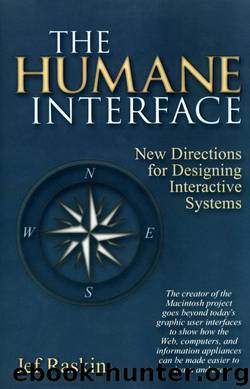The Humane Interface by Jef Raskin

Author:Jef Raskin [Raskin, Jef]
Language: eng
Format: epub, pdf
ISBN: 0-201-37937-6
Publisher: Addison Wesley
Published: 2000-03-29T05:00:00+00:00
5-2-1 Highlighting, Indication, and Selection
Highlighting is adding, by any means, a recognizable distinction to a displayed object. The function of the highlight is to allow the user to determine, by passive observation, that the system has recognized a particular object as having a special status. The semantics of that status are dependent on the nature of the object and on the commands that the user can apply to it. For sighted users, the highlight is usually visual. Examples of visual highlighting mechanisms include brightness reversal, color change, change of contrast, underlining, blinking or other periodic change, and applying a stationary or animated border to an object. Nonvisual highlighting can be shown, for example, by different choice of voices or spoken inflection.
As the user moves the cursor over objects, the object to which the cursor is pointing should be highlighted. In text, the object typically would be an individual character. Highlighting the single object pointed to as a cursor is moved, without any other user action such as clicking, is indication. With indication, the user knows at all times to what object the system thinks she is pointing. In too many present systems, the user must guess at what will be selected or activated when she clicks the GID button; if her guess is incorrect, she will have to try again, wasting time and energy. Indication can be especially valuable when the objects that the user would like to select are small and close together, when they overlap, or when their limits are unclear. Indication is necessary if an interface is designed in accord with the principle of visibility.
The highlighting used for indication must not exhibit too much contrast or be overly dramatic, lest the flickering of objects become annoying as the cursor moves over them; in some situations, it may be helpful not to indicate objects when the cursor is moving faster than a threshold velocity. Note that a smaller object, as measured by the visual angle the indicated object subtends, requires higher visual contrast of the indication, but this is an ergonomic issue.
Indication is underused in present systems. If you use indication aggressively in your interface design, you can eliminate a good deal of clicking inherent in present designs. In fact, indication can often replace clicking, and clicking can be used, as when you follow a link in a browser by means of a single click, in place of double clicking. For example, say that a user wants to remove inactive windows from a display. Each window has a Close button. The Macintosh operating system requires that the user first click on a window to make it active and only then click on the Close button to banish the window. This extra click—the one that activates a window just so that the user can close it—is especially annoying. If, however, merely moving the cursor over a window made it active, a single click on the Close button would close it. Of course, if you design a system that exhibits
Download
This site does not store any files on its server. We only index and link to content provided by other sites. Please contact the content providers to delete copyright contents if any and email us, we'll remove relevant links or contents immediately.
The Mikado Method by Ola Ellnestam Daniel Brolund(20603)
Hello! Python by Anthony Briggs(19898)
Secrets of the JavaScript Ninja by John Resig Bear Bibeault(18208)
Dependency Injection in .NET by Mark Seemann(18107)
The Well-Grounded Java Developer by Benjamin J. Evans Martijn Verburg(17575)
Kotlin in Action by Dmitry Jemerov(17183)
Sass and Compass in Action by Wynn Netherland Nathan Weizenbaum Chris Eppstein Brandon Mathis(13265)
Secrets of the JavaScript Ninja by John Resig & Bear Bibeault(11381)
Jquery UI in Action : Master the concepts Of Jquery UI: A Step By Step Approach by ANMOL GOYAL(9386)
Svelte with Test-Driven Development by Daniel Irvine(8139)
Test-Driven Development with PHP 8 by Rainier Sarabia(7888)
Layered Design for Ruby on Rails Applications by Dementyev Vladimir;(7707)
Web Development with Django by Ben Shaw Saurabh Badhwar(7216)
React Application Architecture for Production by Alan Alickovic(6899)
Software Architecture for Web Developers by Mihaela Roxana Ghidersa(4980)
Audition by Ryu Murakami(4888)
Accelerating Server-Side Development with Fastify by Manuel Spigolon Maksim Sinik & Matteo Collina(4837)
Solidity Programming Essentials by Ritesh Modi(4565)
Build Your Own Web Framework in Elixir by Aditya Iyengar(4438)
